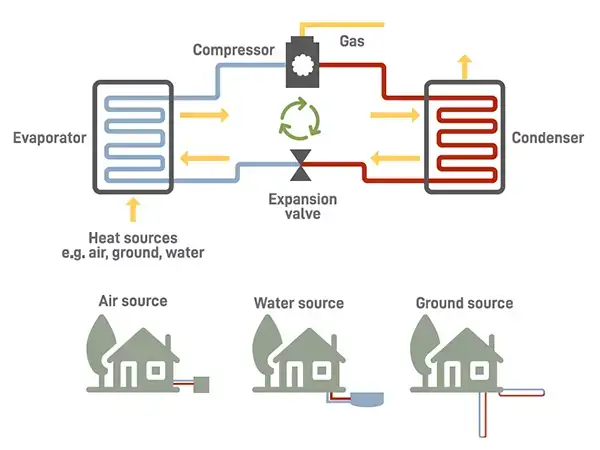A heat pump extracts natural heat from a medium using ‘reverse-refrigeration’ processes. The medium is typically air (air source heat pump – ASHP) which has a varying temperature; ground (GSHP) or water (WSHP) whose temperature varies less than air.

Heat pump principles.
A heat pump uses electricity to concentrate heat from the medium by using a vapour compression cycle. Heat pumps increase the temperature received from air/ground/water by compressing a refrigerant gas which heats up because the heat energy is concentrated into a small space. A heat exchanger transfers the heat to the heating circuit of the building. When the high-pressure gas gives up its heat, pressure is released through an expansion valve, whereupon it becomes very cold. Heat is then transferred to the cold coolant via the source.
ASHPs are typically ‘air to water’ (heat transferred in a hot water circuit) and less commonly ‘air to air’.
All heat pumps have a ‘coefficient of performance (COP)’, i.e. the ratio of useful heat energy produced to the amount of electrical energy consumed. Thus, a COP of 3 means that the heat pump will supply 3 kilowatt-hours (kWh) of heat for every 1 kWh of energy that it uses.
A fossil boiler has a circuit temperature typically set at a default of 65oC-70oC and could be sized using a set of relatively rough parameters since extra energy could be easily obtained by burning more fuel. With the low-grade heat of an ASHP which is around 35oC-50oC the design approach is different.
If an ASHP is retrofitted to a building, larger radiators may be required. Installers have to balance a number of factors to size the heat pump and optimise the installation. These include taking into account local climate, the heating circuit flow rate and temperature, the heat transfer from emitters (radiators/underfloor heating) and building losses from poor insulation and draughts.
A study of air and ground source heat pumps by Fraunhofer found that those retrofitted to buildings worked perfectly well with radiators, although systems with the highest efficiencies had the lowest flow temperatures (~35oC) and (typically) underfloor heating.
For an average UK dwelling, ASHP costs vary between £8000 – £17000 and are cheaper to install than GSHP or WSHP. The cost of heat pumps is still well in excess of a gas boiler. It is envisaged that costs will come down as more are installed; for example Octopus Energy has highly ambitious plans to drive the cost down to parity with boilers and have built an R&D centre to do that, as well as training installers and further optimising the technology.
The UK also ranks below the European average on gas prices and above it on electricity prices, a factor which further discourages electrification unless some self-generation is available. The UK government has now confirmed that gas boilers will be banned from new housing in 2025, and all households will no longer be able to buy gas boilers from 2035. To encourage this transition to low carbon heating a Boiler Upgrade Scheme has been launched, which offers installers up to £5,000 off the cost and installation of a biomass boiler, £7,500 off the cost and installation of an air source or ground source heat pump.
A ground source heat pump extracts ground heat through a system of pipes and a heat exchanger (powered by electricity) to the heat pump. It can be installed using a borehole or in shallow trenches. Because the ground acts as a large thermal store (both a heat sink and a heat source), the ground temperature varies much less than that of air and thus the COP variance is much smaller.
A ground source heat pump is very efficient: it can deliver 3 to 4 kW of heat for every 1 kW of electricity it consumes. For example, the COP of a GSHP with access to a ground temperature of 10oC (typically constant ground temperature at 10 m depth) will be significantly higher than that of an air source heat pump with access to -5oC from the ambient air.
This concept of utilising the earth as a heat sink by putting waste heat (e.g. from solar thermal, heat pump) from warm weather into the ground and retrieving it during times of cold weather works well with ground source heat pumps. It has been marketed by ICAX as ‘Interseasonal Heat Transfer’ and used for both heating and cooling.
A water source heat pump can extract heat from an underground aquifer or from a river or lake; again, water does not have the temperature variability of air. Professional advice is required in order to assess the geology and potential environmental considerations, as well as the heat pump design and installation.
The Wales and West ‘Freedom’ project converted 75 houses to use a combination of heat pump and gas boiler, coupled with a smart controller which predicted the user’s needs. By switching between gas and electricity, this avoids electricity use at peak demand and can benefit from time-of-use pricing (i.e. utilising electricity at the cheapest times).
Further resources (including case studies) on heat pumps are available from many sources, including the Ground Source Heat Pump Association (GSHPA) and the Heat Pump Association, as well as from podcasts such as BetaTalk – The Renewable Energy and Low Carbon Heating Podcast. A series of case studies are available from the GSHPA and from the Element Energy report for DECC on heat pumps for district heating. This latter report is less applicable to farms, but an important option for off grid rural heating.
